Evaluation of the Apprenticeship Grants
From: Employment and Social Development Canada
On this page
- Highlights
- Summary of key findings
- Management response and action plan
- Role of government
- Recommendation
- Annex 1 – Profile of grant recipients
- Annex 2 – Apprenticeship Grants logic model
- Annex 3 – Lines of evidence
- Annex 4 – Description of lines of evidence
- Annex 5 – Limitations
- Annex 6 – Financial barriers faced by apprentices
- Annex 7 – Other barriers or factors affecting apprenticeship progression and completion.
- Annex 8 – Factors affecting take-up rates
- Annex 9 – Awareness rate by trade group
- Annex 10 – Bibliography
Alternate formats

Evaluation of the Apprenticeship Grants [PDF - 1.16 MB]
Large print, braille, MP3 (audio), e-text and DAISY formats are available on demand by ordering online or calling 1 800 O-Canada (1-800-622-6232). If you use a teletypewriter (TTY), call 1-800-926-9105.
List of tables
- Table 1: Description of the Apprenticeship Grants
- Table 2: Profile of Apprenticeship Grants recipients by gender
- Table 3: Profile of Apprenticeship Grants recipients by province
- Table 4: Profile of grant recipients by demographics
- Table 5: Mean of the profile of grant recipients
- Table 6: Cost of technical training by province/territory
List of figures
- Figure 1: Proportion of National Apprenticeship Survey 2015 saying that the grants encouraged them to complete the apprenticeship
- Figure 2: Apprenticeship Grants help me cover the costs of apprenticeship training
- Figure 3: Proportion of Grants recipients receiving support from Employment Insurance and/or Canada Apprenticeship Loan by year
- Figure 4: Proportion of Grants recipients receiving support only from the Apprenticeship Grants from 2007 to 2016, by gender
- Figure 5: Reasons for not completing an apprenticeship for women
- Figure 6: Reasons for not completing an apprenticeship for Indigenous
- Figure 7: Apprenticeship Grants take-up rate
- Figure 8: Awareness rate and application rate of Apprenticeship Grants by gender and Indigenous status
- Figure 9: Reasons for not completing apprenticeship by gender and Indigenous status
- Figure 10: Awareness rate of Apprenticeship Incentive Grant by year
- Figure 11: Awareness rate of Apprenticeship Completion Grant by year
- Figure 12: Awareness and take-up rates of Apprenticeship Grants by trade group
Highlights
Purpose
This evaluation examines the relevance and performance of the Apprenticeship Incentive Grant and the Apprenticeship Completion Grant, in particular the achievement of outcomes and results.
The Apprenticeship Incentive Grant, the Apprenticeship Completion Grant and the Apprenticeship Incentive Grant for Women are the 3 components of the Apprenticeship Grants program. In 2017 to 2018, over 66,000 grants were issued - totaling almost $89 million in disbursements.
The Apprenticeship Grants program allows apprentices to receive up to $4,000Footnote 1 in lifetime grants to pay for tuition, travel, tools, or other expenses. They aim to increase access to skilled trades by reducing financial barriers and encouraging progression and completion of an apprenticeship program.
The evaluation covers calendar years 2007 to 2016Footnote 2 and complies with the 2016 Treasury Board Policy on Results as well as with Federal Administration Act requirements.
Summary of key findings
The Apprenticeship Grants contribute to the decision to continue in, and ultimately complete, an apprenticeship training. However, the grant's incentive is perceived to be limited, as a majority of key informants and a vast majority of focus groups participants view the Apprenticeship Grants as a "bonus" and not as an incentive.
Financial burdens continue to be an issue for apprentices, especially for some under-represented groups, such as women and the Indigenous population.Footnote 3
Apprentices face significant non-financial barriers such as job instability, lack of access to apprenticeship training, unsupportive employers and a stigma regarding women entering the trades as a career choice.Footnote 4
Apprenticeship Grants recipients also received support from Employment Insurance and the Canada Apprentice Loan in various degrees.
Usage of the Apprenticeship Grants, the Canada Apprentice Loan, and Employment Insurance varies by gender and region. For instance, women are more likely to receive support only from the Apprenticeship Grants.
Employment Insurance is perceived by key informants to be a significant support, especially for apprentices.
Awareness of both the Apprenticeship Incentive Grant and Apprenticeship Completion Grant varies across gender and trade groups. Awareness of the grants is lower for women and in some trades, such as hairstylists and cooks, where women are over-represented.
Take up for the Apprenticeship Incentive Grant has decreased from 74.8% to 65.7% between 2010 and 2018 while take-up for the Apprenticeship Completion Grant has decreased from 85.9% to 73.3% between 2011 and 2018.
Many factors contributed to challenges regarding the take-up rates. Grant recipients learned about the grants once they entered their apprenticeship program rather than prior to the application period as intendedFootnote 5. Most of the eligible recipients who did not apply for both grants mentioned that it was because they believed they were not eligible. Some recipients spoke about the application process being confusing and having too many steps.
The majority of key informant interviewees indicated that the Apprenticeship Grants do not help under-represented groups enter apprenticeship training.Footnote 6
Management response and action plan
Recommendation
Examine how the grants could be modified as part of the broader suite of federal apprenticeship supports by taking into account key evaluation findings, including challenges/barriers faced by groups such as, women, and Indigenous people.
Management response
The Skills and Employment Branch and the Transformation and Integrated Service Management Branch would like to thank the Evaluation Directorate and all parties involved in conducting the 2017 to 2019 evaluation of the Apprenticeship Grants program, in particular, the contribution of all stakeholders, key informants, and program officials consulted.
Apprenticeship Grants are intended to help apprentices pursue and complete their training in Red Seal trades. The program comprises three grants: the Apprenticeship Incentive Grant; the Apprenticeship Incentive Grant for Women that is currently being piloted to encourage women to pursue careers in Red Seal trades, where they are underrepresentedFootnote 7 and the Apprenticeship Completion Grant. Eligibility for this program is tied to the Red Seal trades which support the mobility of skilled tradespeople based on national standards.
The fundamental issue examined in the evaluation was whether or not the grants contribute to attracting new apprentices to the trades and support apprentice progression and completion. In addition, the evaluation examined: (i) the financial barriers to apprenticeship progression and completion and the extent to which the grants and other factors are influential to reducing these barriers, (ii) awareness levels and their impact on take-up, and (iii) the effectiveness of service delivery.
Management agrees with the evaluation recommendation. It aligns with Budget 2019 direction, to examine options to realign program objectives within a Pan-Canadian Apprenticeship Strategy to maximize the effectiveness of federal investments in Apprenticeship.
Action plan
As part of the Budget 2019 engagement to develop a new apprenticeship strategy, consultations will be conducted in 2019. These will also help inform whether and how the Apprenticeship Grants should be modified as part of the broader suite of federal apprenticeship supports. Results from the consultations, as well as the key evaluation findings, including challenges/barriers faced by groups such as women and Indigenous, will be analysed and used to develop the recommendations that will follow before the end of 2020. These findings will also inform potential changes to the Apprenticeship Grant logic model.
The Grants provide support to pursue and complete apprenticeships in the Red Seal trades.
| Type of Grant | Description | Launch date | Number of Grants issued since inceptionFootnote 8 |
|---|---|---|---|
| Apprenticeship Incentive Grant | $1,000 per year/level (maximum $2,000) for first and/or second year of training program | January 2007 | 579,700 (4,100 grants issued per month on average) |
| Apprenticeship Completion Grant | $2,000 upon completion of apprenticeship | July 2009 | 233,400 (2,080 grants issued per month on average) |
| Apprenticeship Incentive Grant for Women (5-year pilot) | $3,000 per year/level (maximum $6,000) for first and/or second year of training program in Red Seal trades where women are under-represented | December 2018 | Over 400 |
Role of government
In 2015, 4 million people in Canada worked in skilled-trade occupations, an estimated 22.1% of employed Canadians.Footnote 9
Completion of apprenticeship can still be a challenge for many apprentices and it can also vary significantly across jurisdictions and trades. Key factors affecting completion include barriers such as financial constraints.
Apprentices who completed their programs are more likely to find employment and have, on average, higher earnings.Footnote 10
80.8% of completers have a permanent job compared with 77.0% of discontinuers.
Those who completed an apprenticeship also have a higher average annual income at $69,512 and hourly wage $33/hour than those who have not completed one at $59,782 annually and $28/hour, respectively.
There is notable under-representation of women, immigrants and visible minorities in apprenticeship programs. For instance, women accounted for 9% of Red Seal apprentices and only 5% when more "traditional" trades, such as baker and hairstylist, are removed.Footnote 11
The Grants are some of several financial supports available to apprentices.Footnote 12
Other than the Apprenticeship Grants, apprentices are eligible to apply for Employment Insurance benefits if they leave their job to attend full-time block release training.Footnote 13
Since 2015, apprentices registered in a designated Red Seal trade apprenticeship with their province or territory (except Quebec) are eligible to apply for the Canada Apprentice Loan. This is an interest-free loan of up to $4,000 per period of technical training with a minimum request of $500.
The Government of Canada also offers tax measures to Red Seal and non-Red Seal apprentices through the Canada Revenue Agency, such as the Tradesperson Tools Deduction, the Apprentice Mechanic Tools Deduction, the Tuition Tax Credit for Certification Examination Fees and the Interest Paid on Student Loans.
There is support available through Provincial/Territorial programs for both apprentices and employers in Red Seal and non-Red Seal trades in excess of the federal financial supports.
The exact type and amount of support varies by jurisdiction and most provinces/territories - excluding Newfoundland and Labrador and Quebec - have grants to offset tuition costs and funding support to partially cover costs during technical training.Footnote 14
Apprentices face multiple costs while enrolled in an apprenticeship program. These costs, especially for tools, can be extensive, increase debt, and delay the purchasing of basic needs.
Most of the recipients (81.5%) agreed that the grants helped them to cover the costs associated with their apprenticeship.
Apprentices have to pay tuition fees for technical training between $0 and $1,500 for a 4 to 12 week block of training.
They also have to pay for books, ancillary fees, tools, and living expenses for those needing accommodations for training.Footnote 15
Purchasing tools required large investments. As a result, apprentices incurred debt and delayed purchasing important necessities.Footnote 16
Financial burdens vary based on a number of factors, including employers' supports, union membership and/or family's support.Footnote 17
The Grants have made a limited contribution towards attracting individuals to apprenticeships due in part to lack of awareness of the program.
Recipients indicated that almost all did not know about the Apprenticeship Grants until they became apprentices. Therefore, the grants have a limited impact on their decision to enroll in an apprenticeship.Footnote 18
Almost all participants stated that the Apprenticeship Incentive Grant and the Apprenticeship Completion Grant were provided after completion rather than when support were most needed during the technical training.Footnote 19
Women participants indicated that the grants had no impact on their decision to enter an apprenticeship program.Footnote 20
Indigenous participants mentioned that the grants had little impact on their decision to enter an apprenticeship program.Footnote 21
The majority of key informant interviewees from employer associations indicated that the Apprenticeship Grants do not help under-represented groups enter apprenticeship training.Footnote 22
The Grants contribute to the decision to continue in and ultimately to complete apprenticeship training.Footnote 23 Footnote 24
72.5% of grant recipients agree that the Apprenticeship Grants encouraged them to complete the apprenticeship.
Females (80.6%), apprentices with a university certificate or diploma (77.7%), cooks (83.5%) and hairstylists (87.4%) felt more encouraged to complete the apprenticeship.
A majority of key informants view the Grants as a "bonus" and not as an incentive. A view also shared by a vast majority of focus group participants.

Text description of Figure 1
| Type of apprentice | Strongly agree | Agree | Disagree | Strongly disagree |
|---|---|---|---|---|
| Total apprentices | 26.3% | 46.2% | 22.4% | 5.0% |
| Male | 25.3% | 46.5% | 23.1% | 5.2% |
| Female | 36.8% | 43.8% | 16.3% | 3.1% |
| Indigenous | 32.7% | 41.1% | 22.1% | 4.1% |
Source: National Apprenticeship Survey 2015
The financial barriers faced by apprentices can be even larger for some under-represented groups, such as women and Indigenous people.
Women mentioned facing additional financial barriers such as childcare expenses, greater out-of-pocket expenses for tools and wage disparities created by sexist hiring practices.Footnote 25
Women are more likely than men to feel that the Apprenticeship Grants help them cover the costs of their apprenticeship training.Footnote 26 Since December 2018 women apprentices can receive up to $6,000 in lifetime grants with the Apprenticeship Incentive Grant for Women.
Indigenous peoples faced financial barriers related to additional cost to accessing an apprenticeship training program since they are more likely to live in remote areas.Footnote 27
Disabled recipients (73.7%) are the least likely to agree that the grants help to cover the costs associated with their apprenticeship, although they represent roughly 1% of the recipients.Footnote 28
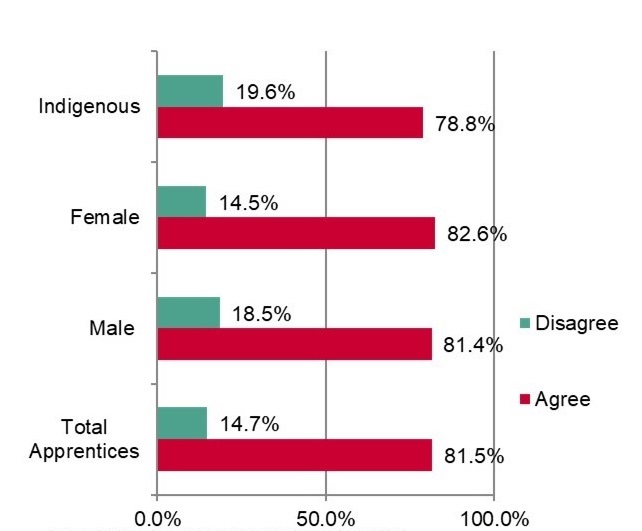
Text description of Figure 2
| Type of apprentice | Agree | Disagree |
|---|---|---|
| Male | 81.4% | 18.5% |
| Female | 82.6% | 14.5% |
| Indigenous | 78.8% | 19.6% |
| Total apprentices | 81.5% | 14.7% |
Source: Statistics Canada, National Apprenticeship Survey 2015
Grant recipients received other financial supports including Employment Insurance and/or the Canada Apprentice Loan.Footnote 29 However, about half of the grant recipients were using these opportunities.
In 2016, 48.8% of the grant recipients were not using other federal financial supports beyond the Apprenticeship Grants limiting their financial capacity to complete an apprenticeship.Footnote 30
There is a perception that Employment Insurance is the most significant support in alleviating financial pressures especially for trades that are seasonal and for which loss of employment can cause hardship.Footnote 31
Employment Insurance is also perceived to be a significant support for apprentices, who tend to be laid off more frequently than journeymen.Footnote 32
Employment Insurance is said to not come in time to reduce shortfalls in income during the technical training.Footnote 33
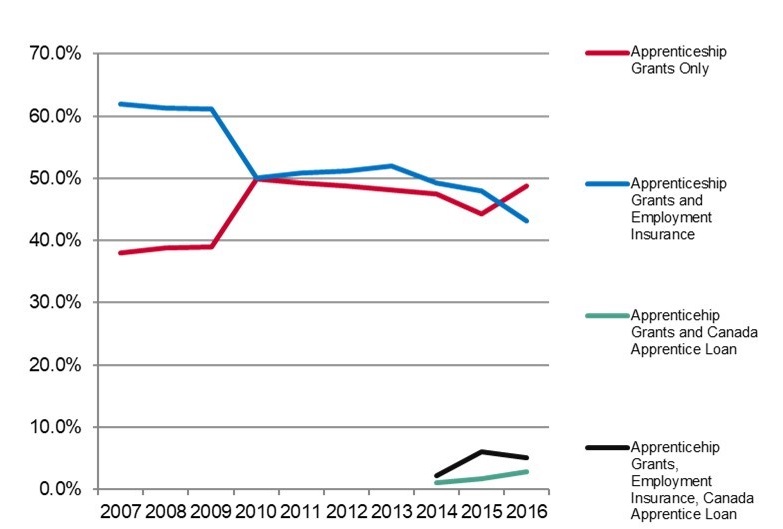
Text description of Figure 3
| Year | Apprenticeship Grants only | Apprenticeship Grants and Employment Insurance | Apprenticeship Grants and Canada Apprentice Loan | Apprenticeship Grants, Employment Insurance, Canada Apprentice Loan | Total recipients |
|---|---|---|---|---|---|
| 2007 | 38.0% | 62.0% | n/a | n/a | 17,032 |
| 2008 | 38.8% | 61.2% | n/a | n/a | 42,274 |
| 2009 | 38.9% | 61.1% | n/a | n/a | 54,127 |
| 2010 | 49.9% | 50.1% | n/a | n/a | 61,925 |
| 2011 | 49.2% | 50.8% | n/a | n/a | 58,190 |
| 2012 | 48.8% | 51.2% | n/a | n/a | 59,196 |
| 2013 | 48.1% | 51.9% | n/a | n/a | 57,707 |
| 2014 | 47.4% | 49.3% | 1.1% | 2.2% | 58,297 |
| 2015 | 44.2% | 47.9% | 1.8% | 6.1% | 60,870 |
| 2016 | 48.8% | 43.2% | 2.9% | 5.1% | 57,735 |
Source: ESDC: Apprenticeship Grants, Canada Apprentice Loans and Employment Insurance Administrative Data. Note that the Apprenticeship Incentive Grant was introduced in 2007, the Apprenticeship Completion Grant was introduced in 2009 and the Canada Apprentice Loan started in 2014.
There are differences in the use of financial supports across recipients.Footnote 35
In 2016, 61.7% of women recipients were not using other federal financial supports beyond the Apprenticeship Grants compared to 45.5% of men.Footnote 36
There is an East-West distinction in terms of pattern of use of the various support measures.
Recipients from Newfoundland and Labrador, Prince Edward Island, Nova Scotia and New Brunswick tend to rely more on Employment Insurance.
Recipients from Manitoba, Saskatchewan, Alberta and British Columbia tend to rely less on Employment Insurance and slightly more on the Canada Apprentice Loan.Footnote 37
There are large disparities in term of Employment Insurance usage during the technical training across trades groups. For instance, around 10% of hairstylists used Employment Insurance compared with 65% of carpenters and construction electricians. This is mainly due to differences in timing of technical training for different apprenticeship programs.Footnote 38
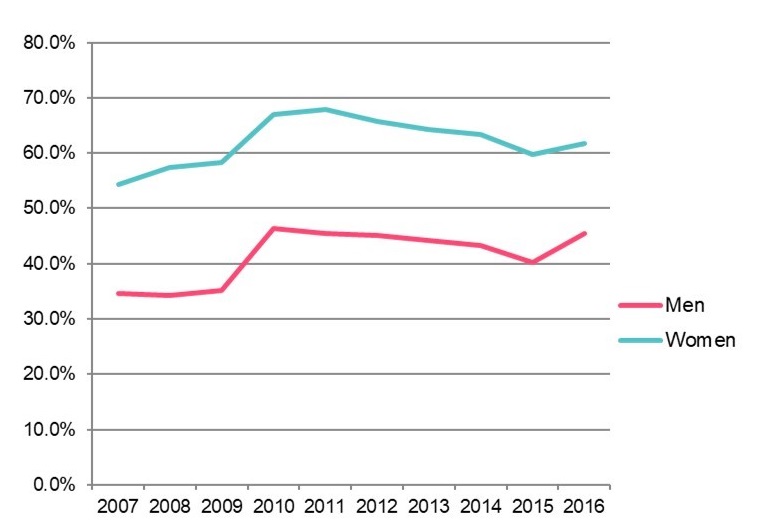
Text description of Figure 4
| Year | Women | Men |
|---|---|---|
| 2007 | 34.5% | 54.3% |
| 2008 | 34.3% | 57.4% |
| 2009 | 35.2% | 58.3% |
| 2010 | 46.4% | 67.0% |
| 2011 | 45.4% | 67.9% |
| 2012 | 45.1% | 65.8% |
| 2013 | 44.1% | 64.2% |
| 2014 | 43.3% | 63.3% |
| 2015 | 40.3% | 59.7% |
| 2016 | 45.5% | 61.7% |
Source: ESDC: Apprenticeship Grants, Canada Apprentice Loan and Employment Insurance Administrative Data
Apprentices face significant non-financial barriers, such as job instability and unsupportive employers.
Factors limiting decision to progress and complete apprenticeship:
- lack of access to education in their community
- unsupportive employers
- having to balance work, training and personal lifeFootnote 39
Three main reasons for not completing their apprenticeship:
- job instability (22.0%)
- received a better job offer (20.3%)
- financial constraint (18.4%)Footnote 40
There is still a stigma for women entering the trades as a career choice.
The main reasons for women not completing their apprenticeship are personal or family issues (24.0%), financial constraints (15.8%) and other (15.6%).Footnote 41
For women additional non-financial barriers include entering a male-dominated workforce and not being taken seriously.Footnote 42
Maternity leave exacerbated gaps in career development especially since employers do not like to see gaps in apprentices' progression.Footnote 43

Text description of Figure 5
| Financial constraints | Received a better job offer | Job instability | Harassment or discrimination | Personal or family issues | Other |
|---|---|---|---|---|---|
| 15.8% | 12.6% | 12.8% | 8.8% | 24.0% | 15.6% |
Source: National Apprenticeship Survey 2015
Indigenous people tend to face unique barriers as living in remote areas further limit their access to education and jobs.
The main reasons for Indigenous people not completing their apprenticeship are financial constraints (29.0%), received a better job offer (21.1%) and personal or family issues (17.5%).Footnote 44
For Indigenous participants the main barrier to enter an apprenticeship is a lack of access to jobs. This barrier may be exacerbated by the fact that some Indigenous apprentices live in remote areas.Footnote 45
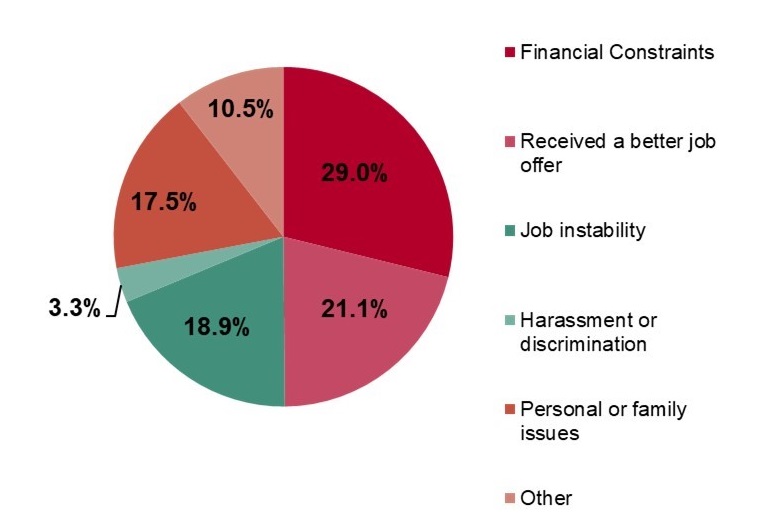
Text description of Figure 6
| Financial constraints | Received a better job offer | Job instability | Harassment or discrimination | Personal or family issues | Other |
|---|---|---|---|---|---|
| 29.0% | 21.1% | 18.9% | 3.3% | 17.5% | 10.5% |
Source: National Apprenticeship Survey 2015
The Apprenticeship Incentive Grant and Apprenticeship Completion Grant take-up rates fluctuates between 65.7% and 89.7%.
The take-up rate for the Apprenticeship Incentive Grant decreased by 9.1 percentage points when comparing 2010 to 2018.
The take-up rate for the Apprenticeship Completion Grant decreased by 12.6 percentage points when comparing 2011 to 2018.Footnote 46
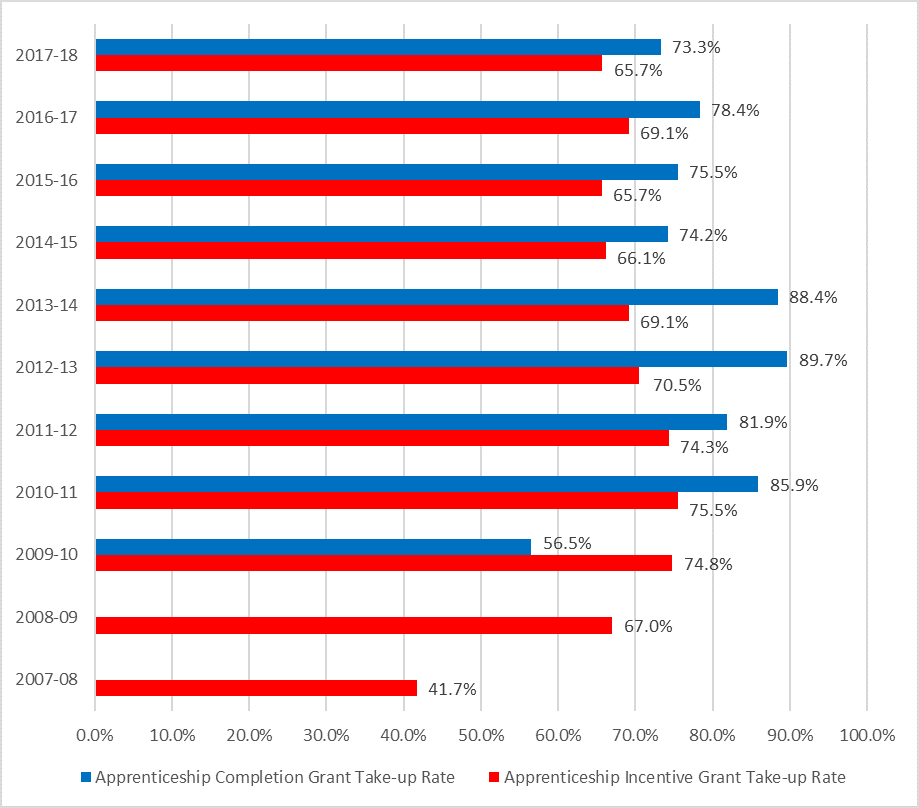
Text description of Figure 7
| Year | Apprenticeship Incentive Grant take-up rate | Apprenticeship Completion Grant take-up rate |
|---|---|---|
| 2007 to 2008 | 41.7% | n/a |
| 2008 to 2009 | 67.0% | n/a |
| 2009 to 2010 | 74.8% | 56.5% |
| 2010 to 2011 | 75.5% | 85.9% |
| 2011 to 2012 | 74.3% | 81.9% |
| 2012 to 2013 | 70.5% | 89.7% |
| 2013 to 2014 | 69.1% | 88.4% |
| 2014 to 2015 | 66.1% | 74.2% |
| 2015 to 2016 | 65.7% | 75.5% |
| 2016 to 2017 | 69.1% | 78.4% |
| 2017 to 2018 | 65.7% | 88.4% |
Many factors negatively impact Grant take-up rates, including the perception that information is confusing.
A majority of the grant recipients learned about the grants once they entered in their apprenticeship. They became aware of the grants from either their instructor or through the college.Footnote 47
Those who did not apply to the Apprenticeship Incentive Grant (24.7%) and Apprenticeship Completion Grant (32.7%) mentioned that they did not apply because they believed they were not eligible.Footnote 48
A barrier for apprentices applying for the Apprenticeship Grants is having to supply 'Protected B' paper documents by mail and not electronically, which can take up to two weeks and can result in delays.Footnote 49
Some participants spoke about the Apprenticeship Grants application process being confusing, with some suggesting that there were many steps.Footnote 50
Information about the Grants is perceived to be confusing, needing greater clarity.
Some participants appeared to not be aware that Service Canada was a resource to find more information and reached out to provincial apprenticeship representatives for more information about the Grants.Footnote 51
Participants related that they were made aware of the Grants from various sources such as:
- a welcoming session to their programs
- the provincial representative who registered them
- discussions with coworkers and school instructors, and
- apprenticeship documentation delivered through the mail - either upon registering into the program or upon completing the examFootnote 52
Most provincial and territorial government apprenticeship authorities interviewed claim that lack of awareness of the support measures is unlikely as they make apprentices aware and sometimes they assist them in completing forms.Footnote 53
The awareness rates of both the Apprenticeship Incentive Grant and Apprenticeship Completion Grant varies across gender and trade groups.
Awareness is higher for men compared to women for both grants. For instance, 69.0% of men and 61.4% of women are aware of the Apprenticeship Incentive Grant while 63.9% of men and 56.9% of women are aware of the Apprenticeship Completion Grant.Footnote 54
Awareness of the Grants varies among trade groups. For instance 55.4% and 59.4% of cooks and 74.5% and 78.3% of construction electricians are aware of the Grants.Footnote 55
Some trades such as construction electricians, plumbers or carpenters appear to be more structured and, therefore, have a higher awareness and take-up rate.Footnote 56
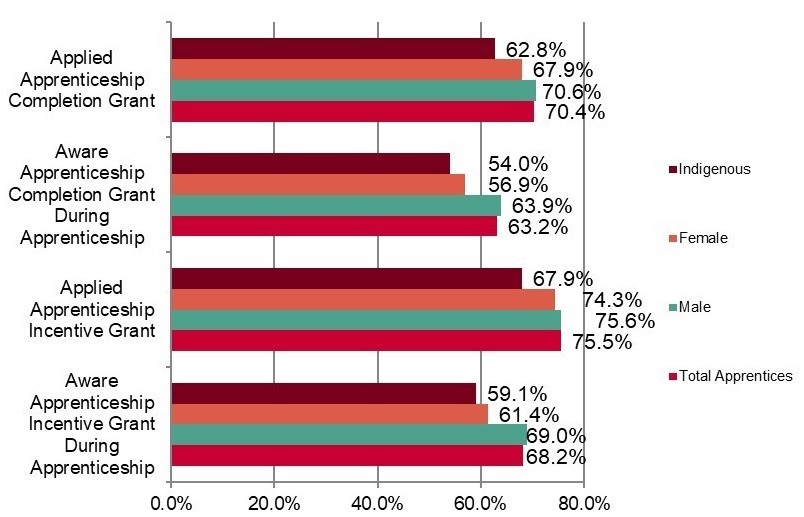
Text description of Figure 8
| Type of apprentice | Aware Apprenticeship Incentive Grant during apprenticeship | Applied Apprenticeship Incentive Grant | Aware Apprenticeship Completion Grant during apprenticeship | Applied Apprenticeship Completion Grant |
|---|---|---|---|---|
| Total apprentices | 68.2% | 75.5% | 63.2% | 70.4% |
| Male | 69.0% | 75.6% | 63.9% | 70.6% |
| Female | 61.4% | 74.3% | 56.9% | 67.9% |
| Indigenous | 59.1% | 67.9% | 54.0% | 62.8% |
Source: National Apprenticeship Survey 2015
There is a consistent perception that the application process for the Grants is straightforward, although the supporting documentation and application deadlines may limit the ability of some eligible apprentices to receive the Grants.
Between 98% and 100% of all Apprenticeship Grants are processed in 28 calendar days and that a similar proportion of grants is disbursed within that period.Footnote 57
Various strengths of the current service delivery of the Apprenticeship Grants were noted including:
- experienced staff
- meeting the 28 day timeline to process applications and disburse funds
- flexibility in making changes at the local level given their knowledge of the program
- the ability of clients to be able to apply online and have paper format accessibleFootnote 58
Participants mentioned that they were generally able to access the information they required and experienced few challenges with the application process.
However, there was room for improvement; in particular, some participants found the information was too complex, the application forms too long, and the need to submit certificates of completion unnecessary.Footnote 59
Recommendation
Examine how the grants could be modified as part of the broader suite of federal apprenticeship supports by taking into account key evaluation findings, including challenges/ barriers faced by groups such as, women, and Indigenous people.
Annex 1 – Profile of grant recipientsFootnote 60
| Gender | Number | Percent |
|---|---|---|
| Females | 32,242 | 9.1% |
| Males | 290,946 | 81.8% |
| Not Declared | 32,425 | 9.1% |
| Total | 355,613 | 100.0% |
| Province of residence | Number | Percent |
|---|---|---|
| Alberta | 92,266 | 25.9% |
| Ontario | 89,782 | 25.2% |
| Québec | 61,579 | 17.3% |
| British Columbia | 53,405 | 15.0% |
| Saskatchewan | 16,452 | 4.6% |
| Manitoba | 12,848 | 3.6% |
| New-Brunswick | 9,292 | 2.6% |
| Newfoundland and Labrador | 8,516 | 2.4% |
| Northwest Territories | 8,327 | 2.3% |
| Prince-Edward-Island | 1,886 | 0.5% |
| Nova Scotia | 589 | 0.2% |
| Yukon | 587 | 0.2% |
| Nunavut | 80 | 0.0% |
| Total | 355,609 | 100.0% |
| Apprenticeship Grants | ||
|---|---|---|
| Demographics | Number | Percent |
| Indigenous | 2,565 | 0.7% |
| Non-Indigenous | 353,048 | 99.3% |
| Total | 355,613 | 100.0% |
| Disabled | 3,041 | 0.9% |
| Non-disabled | 339,624 | 99.1% |
| Total | 342,665 | 100.0% |
| Visible Minority | 24,642 | 7.3% |
| Non-visible Minority | 314,925 | 92.7% |
| Total | 339,567 | 100.0% |
| Mean | |
|---|---|
| Average age | 27.98 |
| Average number of Apprenticeship Grants received | 1.95 |
Annex 2 – Apprenticeship Grants logic model
Annex 2 illustrates the logic model of the Apprenticeship Grants which outlines, from the top to the bottom, its mission, activities, outputs, immediate outcomes, intermediate outcomes, ultimate outcome and the strategic outcome the program intends to achieve or to which it intends to contribute.
Inputs
To encourage and reward individual effort in progressing along a Red Seal apprenticeship program to meet Canada's future need for skilled trades people that is crucial to the sustained growth of the economy
Activities
The inputs lead to the following activities:
- Promoting awareness of grants
- Delivering grants
Outputs
These activities lead to the following outputs:
- Communications products and activities
- Processed applications and payments to recipients
Immediate outcomes
These outputs lead to the following immediate outcomes:
- Increased awareness of grants
- Increased financial resources to support participation in apprenticeship programs
Intermediate outcomes
These immediate outcomes lead to the following intermediate outcomes:
- Increased participation in apprenticeship programs, increased progression through each level, including to completion
Ultimate outcome
These intermediate outcomes lead to the following ultimate outcome:
- Improved completion rates in apprenticeship programs
- Enhanced interprovincial mobility of Red Seal certification
Alignment with Employment and Social Development Canada management resources and results structure
This ultimate outcome aligns with the Employment and Social Development Strategic Outcome:
- Enhanced Canadian productivity and participation through efficient and inclusive labour markets, competitive workplaces and access to learning.
Annex 3 – Lines of evidence
Evaluation question:
4.1 The impact of the Grants on the number of new apprentices and on the progression and completion of apprenticeships.
Lines of evidence: National Apprenticeship Survey 2015, Documents Review, Key Informants Interviews, Focus Groups, Apprenticeship Grants administrative data.
4.2 Financial barriers to apprenticeship progression and completion.
Lines of evidence: Documents Review, Key Informants Interview, Focus Groups and National Apprenticeship Survey 2015.
4.3 The role of other financial supports in addressing financial barriers.
Lines of evidence: Key Informants Interview, Focus Groups, National Apprenticeship Survey 2015 and Linked Apprenticeship Grants, Canada Apprentice Loan and Employment Insurance administrative data analysis.
4.4 The role of other barriers or factors affecting apprenticeship progression and completion
Lines of evidence: Key Informants Interview, Focus Groups, Documents Review and National Apprenticeship Survey 2015.
4.5 The level of awareness of the Grants and how does this or other factors affect take-up rates
Lines of evidence: Key Informants Interview, Focus Groups and National Apprenticeship Survey 2015.
4.6 The effectiveness of service delivery and the challenges to be addressed
Lines of evidence: Key Informants Interview and Focus Groups.
Annex 4 – Description of lines of evidence
Documents review
Compiles information from public documents, external published studies, internal Employment and Social Development Canada documents, and aggregated administrative data
Key informant interviews
The key informant interviews were undertaken with:
- 3 National Headquarters members of program management
- 11 provincial and territorial government apprenticeship authorities
- 3 technical training providers
- 4 Employer Associations, and
- 5 Service Canada regional staff
Focus groups
Discussions with 61 grant recipients divided in 8 groups.
- 3 groups for Apprenticeship Incentive Grant recipients
- 3 groups for Apprenticeship Completion Grant recipients
- 1 group of women recipients
- 1 group of Indigenous recipients
National Apprenticeship Survey 2015
A stratified sample of 28,469 apprentices (17,215 completers and 11,254 non-completers) between 2011 and 2013 was surveyed by Statistics Canada between September 2015 and March 2016.
Linked Apprenticeship Grants, Employment Insurance and Canada Apprentice Loan data analysis
The population of grant recipients linked to Employment Insurance and Canada Apprentice Loan databases.
Linked Employment and Social Development Canada with Registered Apprenticeship Information System data analysis
The population of Red Seal apprentices linked to the Apprenticeship Grants, Employment Insurance and Canada Apprentice Loan databases.
Annex 5 – Limitations
Findings from this evaluation do not include an analysis of the net impacts of the program on the completion and progression rates of the apprentices in their training. Therefore, the evaluation is only looking at contributions of the program activities on enrollment, persistence and graduation of apprentices.
Pre-program data were not available to study the impact of the program on attracting new apprentices in the skilled-trade field. However, given the comprehensive qualitative analysis conducted, these responses adequately address the evaluation questions.
Sample size for groups of apprentices such as women and Indigenous were too small to disaggregate the analysis and conduct a comprehensive Gender Based Analysis+ analysis.
Women and Indigenous specific focus groups provided a unique perspective of the barriers faced but there were challenges with the composition of these groups.
Five out of 6 of the women's group were in the same trade limiting the capacity to generalize about all groups and trades.
The Indigenous group was conducted via teleconference as there were difficulties in recruiting an adequate number of participants.
Annex 6 – Financial barriers faced by apprentices
| Province or territory | Regulated | Amount per week | Estimated cost: 4-week block training | Estimated cost: 12-week block training |
|---|---|---|---|---|
| Newfoundland and Labrador | No | $49 | $196 | $588 |
| Prince Edward Island | Yes | $0 | $0 | $0 |
| Nova Scotia | Yes | $90 | $360.80 | $1,082.40 |
| New Brunswick | Yes | $85 | $340 | $1,020 |
| Ontario | No | Varies | $200 | $800 |
| Manitoba | Yes | $200 for first 8 weeks, $25 each week thereafter | $200 | $300 |
| Saskatchewan | Yes | $85 (minimum $300)Footnote 62 | $340 | $1,020 |
| Alberta | Yes | $98 | $392 | $1,176 |
| British Columbia | No | Varies | $168 | $1,500 |
| Northwest Territories | Yes | $98 | $392 | $1,176 |
| Yukon | Yes | $0 | $0 | $0 |
| Nunavut | n/a | $1,360 (flat fee) | $1,360 | $1,360 |
Annex 7 – Other barriers or factors affecting apprenticeship progression and completion.
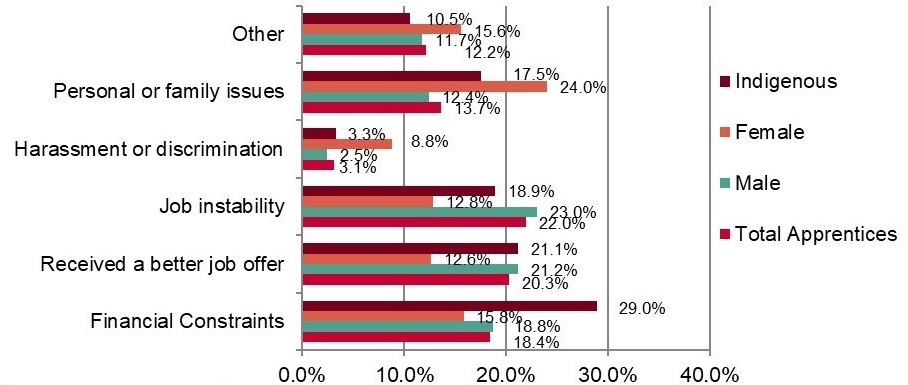
Text description of Figure 9
| Type of apprentice | Financial constraints | Received a better job offer | Job instability | Harassment or discrimination | Personal or family issues | Other |
|---|---|---|---|---|---|---|
| Total apprentices | 18.4% | 20.3% | 22.0% | 3.1% | 13.7% | 12.2% |
| Male | 18.8% | 21.2% | 23.0% | 2.5% | 12.4% | 11.7% |
| Female | 15.8% | 12.6% | 12.8% | 8.8% | 24.0% | 15.6% |
| Indigenous | 29.0% | 21.1% | 18.9% | 3.3% | 17.5% | 10.5% |
Source: National Apprenticeship Survey 2015
Annex 8 – Factors affecting take-up rates
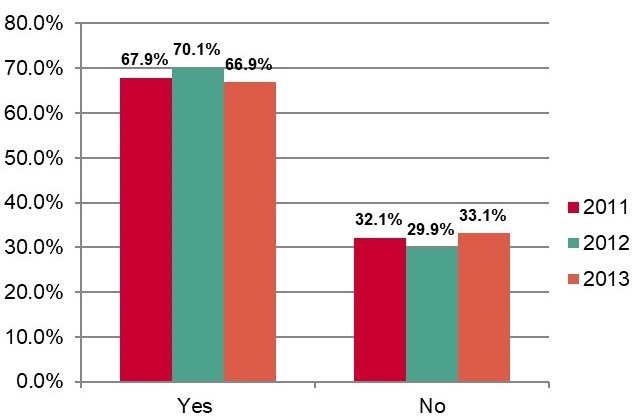
Text description of Figure 10
| The Awareness of the Apprenticeship Incentive Grant for Apprentices in Red Seal Trades/Blank by family situation, demographics, and apprenticeship characteristics Pooled (weighted) | ||
|---|---|---|
| Year | Yes | No |
| 2011 | 67.9% | 32.1% |
| 2012 | 70.1% | 29.9% |
| 2013 | 66.9% | 33.1% |
Source: National Apprenticeship Survey 2015
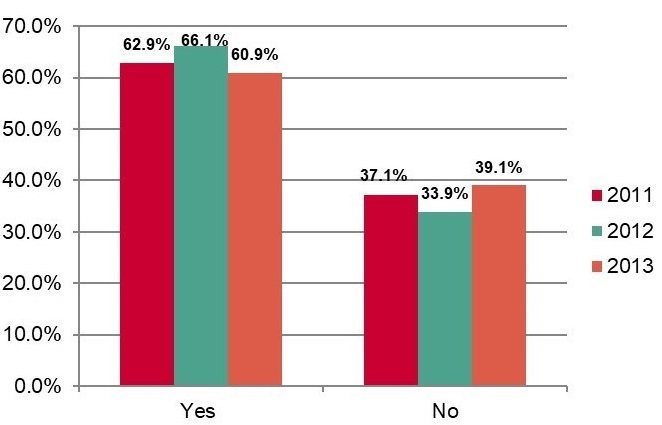
Text description of Figure 11
| Awareness of Apprenticeship Completion Grant by year | ||
|---|---|---|
| Year | Yes | No |
| 2011 | 62.90% | 37.10% |
| 2012 | 66.10% | 33.90% |
| 2013 | 60.90% | 39.10% |
Source: National Apprenticeship Survey 2015
Annex 9 – Awareness rate by trade group
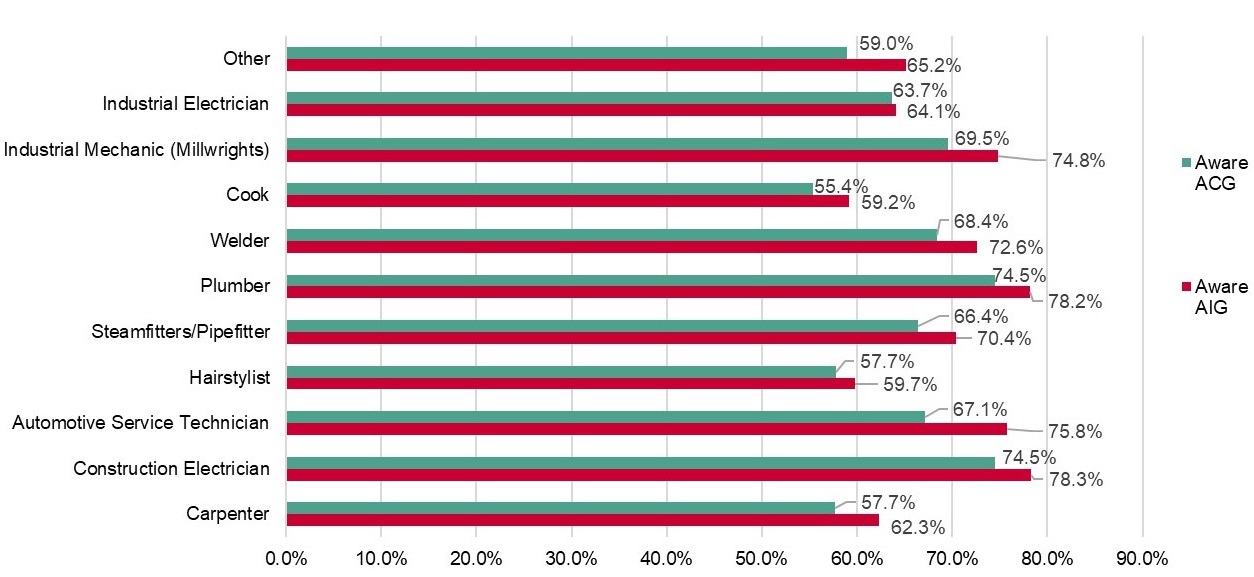
Text description of Figure 12
| Trade group | Aware of Apprenticeship Incentive Grant | Aware of Apprenticeship Completion Grant |
|---|---|---|
| Carpenter | 62.3% | 57.7% |
| Construction Electrician | 78.3% | 74.5% |
| Automotive Service Technician | 75.8% | 67.1% |
| Hairstylist | 59.7% | 57.7% |
| Steamfitters/Pipefitter | 70.4% | 66.4% |
| Plumber | 78.2% | 74.5% |
| Welder | 72.6% | 68.4% |
| Cook | 59.2% | 55.4% |
| Industrial Mechanic (Millwrights) | 74.8% | 69.5% |
| Industrial Electrician | 64.1% | 63.7% |
| Other | 65.2% | 59.0% |
Source: National Apprenticeship Survey 2015
Annex 10 – Bibliography
Employment and Social Development Canada (2018), "Evaluation of the Apprenticeship Grants Program Key Informant Interview Summary of Findings." (not published, available on demand)
Employment and Social Development Canada (2018), "Evidence from the National Apprenticeship Survey (NAS - 2015)." (not published, available on demand)
Employment and Social Development Canada (2018), "Document Review for the Evaluation of the Apprenticeship Grants (AG) Program." (not published, available on demand)
Employment and Social Development Canada (2019), "The Patterns of Use of Employment Insurance and Canada Apprentice Loan among Apprenticeship Grants Recipients: Evidence from the Linked Apprenticeship Grant, Canada Apprentice Loan and Employment Insurance Administrative Databases." (not published, available on demand)
Frank, Christine and Emily Jovic, "National Apprenticeship Survey 2015: Canada Overview Report", Statistics Canada, March 2017
Frank, Kristyn and Marc Frenette, "How Do Women in Male-dominated Apprenticeships Fare in the Labour Market?" Statistics Canada, March 2019
R. A. Malatest and Associates (2018), "Focus Groups for the Summative Evaluation of the Apprenticeship Grants: Synthesis Report." (not published, available on demand)